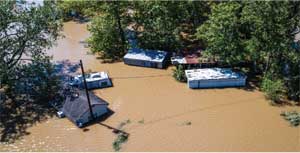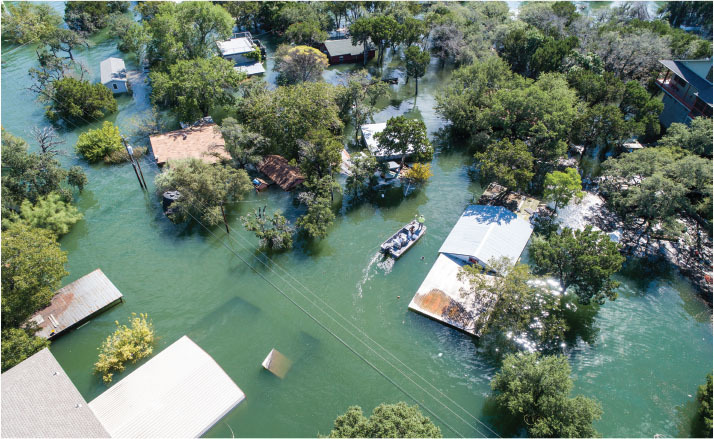September/October 2018
Concepts
Ethics, Public Policy, and Managing Disaster Risk
BY LARRY LARSON, P.E., CFM
 Engineers often feel more comfortable with the technical aspects of design, construction, and operation of infrastructure than speaking about natural disaster risks and their impact on public safety. Many engineers are not comfortable weighing in on policies that may exacerbate disasters, or greatly increase the risk for disasters. With the tools we have today, engineers can no longer claim they don’t know if their decisions or actions will impact disasters.
Engineers often feel more comfortable with the technical aspects of design, construction, and operation of infrastructure than speaking about natural disaster risks and their impact on public safety. Many engineers are not comfortable weighing in on policies that may exacerbate disasters, or greatly increase the risk for disasters. With the tools we have today, engineers can no longer claim they don’t know if their decisions or actions will impact disasters.
At the local level, some engineers see the decision of where to allow development as a local government decision, and believe that she or he simply designs and builds according to those decisions. However, engineers have a code of ethics, and have the technical skills to know whether a proposal is in the public interest. Will it be safe—now and over its expected life span? Will it encourage added development that will put people and property at risk? Will it look like a less expensive project in the short term, but cost more in maintenance, operation, and update costs over the life of the project?
There are two major areas in which engineers must take an active role and inform decision-makers about what could negatively impact public safety. The first consideration is where to build. Avoiding construction in a flood-prone area will often be safer and cheaper to taxpayers in the long run. If there is no other option than to build in a floodplain, then the structure needs to be built so that it can withstand future flooding. Engineers now realize floods are often higher and faster than computers model project. So, even if the National Flood Insurance Program requires that structures in floodplains are built at least one foot higher than the last flood, engineers can determine if it is much safer and more cost-effective to build several feet higher than what’s required.
 Another question often ignored is, “What is the impact of that building or development going to have on other properties or communities?” Ethics tell us those impacts must be lessened or prevented before development occurs. People often buy homes and businesses and have no idea about the flood risk. A perfect example is when developers built homes in the reservoir pools of Addicks and Barker Dams in Houston. That area is exactly where excess rainfall and stormwater is supposed to go during a flood situation. The flood impact was not mitigated and, in fact, it put thousands of people at risk and they had no idea.
Another question often ignored is, “What is the impact of that building or development going to have on other properties or communities?” Ethics tell us those impacts must be lessened or prevented before development occurs. People often buy homes and businesses and have no idea about the flood risk. A perfect example is when developers built homes in the reservoir pools of Addicks and Barker Dams in Houston. That area is exactly where excess rainfall and stormwater is supposed to go during a flood situation. The flood impact was not mitigated and, in fact, it put thousands of people at risk and they had no idea.
The second major area engineers should not ignore: considering how future conditions will impact a structure or infrastructure projects such as bridges, roads, and levees. Rainfall intensity is increasing, as are coastal storms. That means the projected rainfall and runoff will be larger than in the past. Engineers need to update rainfall and runoff projections to reflect today’s conditions, and construct buildings and infrastructure with that data in mind. We must also project what flood levels will be when the facility or building is at the end of its design life and use that data.
Sea-level rise is another future condition that must be factored into decisions. Most sections of the nation now have some regional sea-level rise projections. These typically might have a low-, mid-, and high-level projection, and engineers should consider which projection to use based on the level of risk to public safety or for the loss of use of the facility or building.
Some engineers will say many of those decisions are not within their authority. In that case, what is your obligation? Ethically, the engineer is in the position to use his or her technical expertise to explain to decision-makers why a future condition or impact must be considered and why. I would ask that engineers educate themselves on the potential liability the community will be subject to if they knowingly permit or build something that will adversely impact others over time. As engineers, we now have the tools to be able to accurately calculate what the impacts will be. For example, will this large development or project in the watershed, even if not in the floodplain, result in significantly increased flooding downstream, across stream, or upstream? Who will suffer? How can those impacts be mitigated? What are the options?
I have used flooding as an example, but these principles can be applied to other natural hazards, water quality, and other issues impacting public safety and quality of life.
Engineers may not have the authority to make final decisions on these matters, but they do have a professional ethical obligation to analyze, inform, and advise what is in the best interests of public safety, now and in the future.
Larry Larson, P.E., CFM, is director emeritus and senior policy advisor for the Association of State Floodplain Managers.


 Volunteering at NSPE is a great opportunity to grow your professional network and connect with other leaders in the field.
Volunteering at NSPE is a great opportunity to grow your professional network and connect with other leaders in the field. The National Society of Professional Engineers (NSPE) encourages you to explore the resources to cast your vote on election day:
The National Society of Professional Engineers (NSPE) encourages you to explore the resources to cast your vote on election day:



